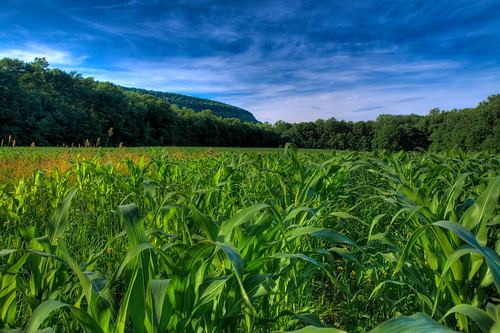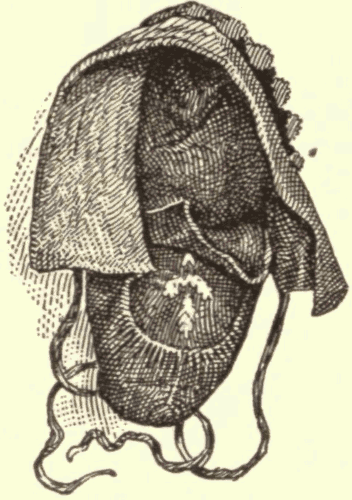"In Iroquois society, leaders are encouraged to remember seven generations in the past and consider seven generations in the future when making decisions that affect the people."
The Iroquois were farmers, and lived in villages surrounded by palisades, which was a fence made from sharpened poles. These native peoples lived in longhouses, that vary between 200 ft long, 20 ft wide, and 20 ft high. Longhouses were large buildings constructed from wooden poles covered with a frame of elm bark, sometimes tied with deer tendons. Smoke holes were placed at the top of the longhouse to allow fire smoke to escape, in winter the holes were covered with hide.
Inside there were two stories, where the sleeping area was on top and the common area placed at floor level. Mats and screens separate each section area for each family, while four families shares one fire. Each longhouse contains one clan, up to about 20 families! Each long house had two separate doors at each end of the building; the entryways were covered with animal hides to keep warmth in. Longhouses had no windows, thus it was dark inside when not alighted by fires. Shelves above the sleeping bunks were used for storage for food, pots, pans, and so on. The dwellings of the Iroquois were settled, intended as permanent accommodations.
Inside there were two stories, where the sleeping area was on top and the common area placed at floor level. Mats and screens separate each section area for each family, while four families shares one fire. Each longhouse contains one clan, up to about 20 families! Each long house had two separate doors at each end of the building; the entryways were covered with animal hides to keep warmth in. Longhouses had no windows, thus it was dark inside when not alighted by fires. Shelves above the sleeping bunks were used for storage for food, pots, pans, and so on. The dwellings of the Iroquois were settled, intended as permanent accommodations.
Living in the fertile St. Lawrence lowland expanse, the Iroquois ate both vegetables as well as meat, they both farm in addition to hunt. Corn, bean plants, squash were the common vegetables harvest by the Iroquois people, these were made into flat breads such as tacos, corncakes, soups, cornmeal, or tortillas, sometimes into warm pudding by boiling the contents in water transforming it into a type of oatmeal.
Iroquois hunted in their forests for deer, rabbits, elk, fish, birds (fowl, turkey, pigeons, etc), raccoons, and even bears, thus in addition to vegetables the Iroquois also ate meat. At times these natives managed to harvest apples and berries, such as wild cherries, strawberries, or huckle berries, along with fruits the Iroquois collected nuts as well, like chestnuts, beechnuts and so on. In fact, the Iroquois used maple sap from maple trees in the forest as a sweetener. Out of all the aboriginals in Canada the Iroquois were the only natives to survive partially on farming, with a much more varied diet.
Iroquois hunted in their forests for deer, rabbits, elk, fish, birds (fowl, turkey, pigeons, etc), raccoons, and even bears, thus in addition to vegetables the Iroquois also ate meat. At times these natives managed to harvest apples and berries, such as wild cherries, strawberries, or huckle berries, along with fruits the Iroquois collected nuts as well, like chestnuts, beechnuts and so on. In fact, the Iroquois used maple sap from maple trees in the forest as a sweetener. Out of all the aboriginals in Canada the Iroquois were the only natives to survive partially on farming, with a much more varied diet.
The Iroquois depending on the season as well as times used various types of transportation. Dugout canoes created from elm bark were a common transportation to travel across water, the Iroquois used dugout canoes created from elm bark. Before the colonists introduced horses from Europe, the Iroquois used dogs as pack animals. The Iroquois used sleds, and snowshoes to travel in winter.
Iroquois clothing was based seasonally, while providing both decoration plus sufficient protections against the elements of nature. They were created usually from deerskin, but other animal skins, elm bark, and various organic materials were also commonly in use. The women wore wrap around skirts, vests, plus moccasins, while decorating their clothing with porcupine quills, shell beads, dyed hair, feathers, and such. Necklaces were stung with wooden or shell beads, animal teeth, as well as many other natural objects.
In northern areas the women and children wore leggings and breechcloths. The Iroquois made rabbit fur capes, shawls, robes, bear fur capes as well, along with leather leggings and tunics, moccasins made from leather or corn husks were also popular among the Iroquois to keep warm in winter. While during a heated summer, men wore deerskin breechcloths. Clothing was decorated with clan symbols, in addition to significant objects found in nature.
In northern areas the women and children wore leggings and breechcloths. The Iroquois made rabbit fur capes, shawls, robes, bear fur capes as well, along with leather leggings and tunics, moccasins made from leather or corn husks were also popular among the Iroquois to keep warm in winter. While during a heated summer, men wore deerskin breechcloths. Clothing was decorated with clan symbols, in addition to significant objects found in nature.
Iroquoian tools were divided into three selections, transportation, hunting weapons, and farming or housing tools. From transportation, the Iroquois used hollowed out log canoes. Knives of sharpened rock tied to wooden handles were used for cutting bark, hunting, as well as scalping enemies in tribal wars. Bone awls were used for poking holes and engraving designs on moist pottery for art. Wooden framed snowshoes were also important, since the Iroquois used these to travel through land in winter.
Weapons to the Iroquois natives were extremely important. Spears were used to catch fish, while bows and arrows were for hunting buffalos, deer, bears; moose was also hunted at times. When lunching war or having to hold a defense against other tribes, bows and arrows were deadly since they were long ranged weapons.
A war club made of carved wood and stone can injure an enemy on the battlefield as well as killing animal preys. In the longhouses, household items used by the Iroquois women were woven baskets for storage or carrying materials, wooden cradleboards that held children upon a mother’s back. Then there was the mortar plus pestle, for crushing corn into cornmeal.
Weapons to the Iroquois natives were extremely important. Spears were used to catch fish, while bows and arrows were for hunting buffalos, deer, bears; moose was also hunted at times. When lunching war or having to hold a defense against other tribes, bows and arrows were deadly since they were long ranged weapons.
A war club made of carved wood and stone can injure an enemy on the battlefield as well as killing animal preys. In the longhouses, household items used by the Iroquois women were woven baskets for storage or carrying materials, wooden cradleboards that held children upon a mother’s back. Then there was the mortar plus pestle, for crushing corn into cornmeal.
Games were played to increase a person’s athletic ability, in means of strength, speed, endurance, and agility. One of the many common games enjoyed in the winter by the Iroquois was called snowsnake. Creating a path among snow, they would pour cold water on to the cleared path. People made long wooden poles to throw across the path, the one’s whose stick slid the furthest would win the race.
In summer children played a game of darts; they were separated into two teams, while each member in the team had six spears or darts to use. Hoops were placed in front of the children, and each with their best accuracy would try to shoot their missiles in through the hoop. The team with the most accurate shots won. However, most of these games were played by the boys, since they were to develop hunting skills and battle techniques strength and agility would be essential.
Girls on the other hand played with husk dolls made of straw and have no faces. Sometimes the girls played house, to develop mothering knowledge. Iroquois games were created to enhance their children’s education in their role throughout life.
In summer children played a game of darts; they were separated into two teams, while each member in the team had six spears or darts to use. Hoops were placed in front of the children, and each with their best accuracy would try to shoot their missiles in through the hoop. The team with the most accurate shots won. However, most of these games were played by the boys, since they were to develop hunting skills and battle techniques strength and agility would be essential.
Girls on the other hand played with husk dolls made of straw and have no faces. Sometimes the girls played house, to develop mothering knowledge. Iroquois games were created to enhance their children’s education in their role throughout life.
The Iroquois Video:



















